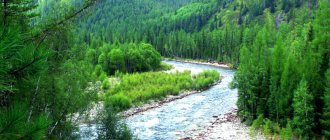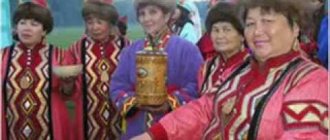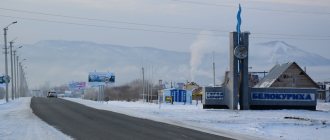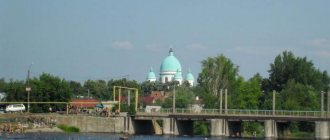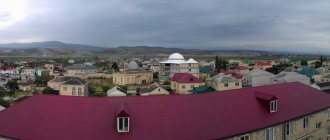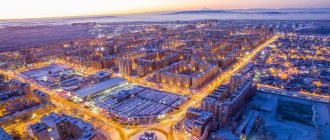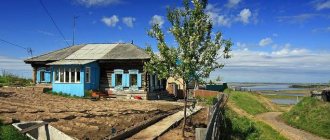Altai Territory was formed in 1937. It is a subject of the Russian Federation, part of the Siberian Federal District. The total population is 2,332,511 people, half of them live in urban areas.
Among the population there are a total of about 30 nationalities, the majority are Russian-speaking, there are many representatives of German and Ukrainian nationality. An increase in natural population growth due to the birth rate has been observed since 2007, but the growth still remains at a low level. The reason is the move of many Altaians to big cities, where they can find better jobs and improve their careers.
The density in the Altai Territory is low, only 14.28 people per km². The unemployment rate is quite low at 2%. The main economic direction of the entire region is agriculture. Many jobs are created and small businesses are supported. Despite this, wages here are not high.
What holiday is it today?
December 16, 2021, Thursday
Today are holidays, events: Events that happened on December 16 in the world, in different years Tomorrow: Day of Strategic Missile Forces Day of Employees of the State Courier Service Memorable date in the military history of Russia: Capture of the Ochakov fortress in 1788
Today is the Orthodox holiday of the Prophet Zephaniah. Reverend Savva of Storozhevsky, Zvenigorod. Martyr Angelis... Tomorrow: Great Martyr Barbara and Martyr Juliania of Iliopolis. Venerable John of Damascus...
Today is a national holiday: Day of World Silence and Silence... Tomorrow: Barbarian Day...
Seasons
Seasons, four periods of the year (spring, summer, autumn and winter) characterized by certain average temperatures. The period during which the Sun passes through one of these sectors is called the season. Spring in the Northern Hemisphere and autumn in the Southern Hemisphere begin when the Sun passes through the initial circle of declination and its right ascension is 0° (vernal equinox). Summer in the Northern Hemisphere and winter in the Southern Hemisphere occur when the sun's right ascension is 90° (summer solstice). Autumn in the Northern Hemisphere and spring in the Southern Hemisphere begin when the sun's right ascension is 180° (autumnal equinox). The beginning of winter in the Northern Hemisphere and summer in the Southern Hemisphere is considered to be the winter solstice, when the direct ascension of the Sun is 270°... Next: Seasons. Russian folk calendar. Monthly words...
Urban settlements
- Southern
Population 19,693 (2020).
- Talmenka
Population 18,933 (2020).
- Siberian
Population 12,142 (2020).
- Blagoveshchenka
Population 11,390 people (2020).
- Steppe Lake
Population 6,262 (2020).
- Raspberry Lake
Population 2,952 (2020).
Folk calendar about every day
Every day one season always replaces another and this determines a person’s way of life. In connection with this, a folk calendar was formed in which there were practically no nameless, unmarked days. Every day was special, had its own purpose. All this was determined by climate conditions and astrological phenomena.
A calendar is a system for counting periods of time. The first calendars arose a long time ago, in ancient times, because there was a need to measure time. The word calendar comes from the Latin words caleo - to proclaim and calendarium - debt book. This is due to the fact that in Ancient Rome the beginning of each month was especially proclaimed, and because it was customary to pay debts on the first day of the month. Different peoples counted time differently. Some calendars are based on the changing phases of the moon - lunar calendars; in others - the change of seasons - sunny; in others, the length of the year was coordinated with the change of seasons, and the counting of months was associated with the phases of the Moon. Such calendars are called lunisolar.
In Rus', the calendar was called a monthly calendar. Every day, the month book covered the entire year of peasant life, “describing” day by day, month after month, where each day had its own holidays or weekdays, customs and superstitions, traditions and rituals, natural signs and phenomena. The cyclical nature of the calendar is reminiscent of human life, where spring is youth, summer is heyday, autumn is the time of harvesting fruits (it’s good if there are some, otherwise you can live your life without collecting fruits), winter is the time of wisdom and peace. This cyclicality and rhythm determined the way of life of the farmer. The folk calendar was an agricultural calendar, which was reflected in the names of the months, folk signs, rituals and customs. Even the determination of the timing and duration of the seasons is associated with real climatic conditions. Hence the discrepancy between the names of the months in different areas... Next: Folk calendar...
List of cities in Altai Krai
There are twelve cities in the Altai Territory, of which ten are of regional importance, and two are of regional importance. The majority of the region’s population lives in them (almost 56%). The largest cities: the capital Barnaul, Novoaltaisk, Rubtsovsk, Kamen-on-Obi, Biysk, Zarinsk. Altai region is a fertile land. Recently, new tourist areas have appeared. The region offers appropriate infrastructure for vacationers.
Barnaul - regional center
Since 1937, Barnaul The city is located in the southern part of Western Siberia, where the Barnaulka River flows into the Ob. More than 670 thousand people live in Barnaul. The large cultural, educational and industrial center has 5 theaters, several state universities, and museums. Interesting architectural monuments of the 18th-20th centuries adorn the city.
Barnaul has a developed transport system. There are many catering outlets and shopping malls. The airport is 17 km from the city. Before the war, Barnaul was an agricultural town, and then in a matter of years it became the industrial center of Siberia. This affected the environmental situation of the entire Altai Territory. The climate of Barnaul is sharply continental. Here the winters have little snow and are quite severe, and the summers are warm.
Climatic and geographical features determined the vegetation of Barnaul. It is characterized by the features of the southern forest-steppe subzone. Various cereal, steppe, floodplain-meadow and forest species of flora grow here. Along the beams grow forests of birch and aspen, which alternate with undergrowth of caragana and rosehip. The magnificent ribbon Barnaul forest lies on the hollow of an ancient drainage. Here you can find almost three dozen species of various woody plants. Bird cherry, poplar, willow, and honeysuckle grow abundantly along the river banks.
Urban development with artificial plantings - parks. There are several of them in Barnaul, including an arboretum. The decoration of the city is the boulevards and squares, which are located near public buildings and along the main streets. Green spaces: poplars, maples, birches, spruces, rowan trees, apple trees help cleanse the city air from industrial and technical emissions.
Large cities of Altai Territory
Biysk arose as a fortress by decree of Peter the Great. This was in 1709. The city, the second most populous in the Altai Territory, is home to the administration of the Biysk region. At one time, Biysk received the title of science city and still bears it with pride. The city is called the cultural capital of the Altai Territory. Having celebrated its three hundredth anniversary, Biysk still symbolizes the gateway to the resort region. All mountain tourist routes start from here. Guests of Biysk will be able to see many architectural monuments. There are more than 270 of them here. There are remarkable archaeological sites, over 5 dozen archaeological monuments, and more than a dozen natural monuments. Biysk is part of the Union of Historical Cities of Russia.
Zarinsk is the center of the Zarinsky district. The city appeared as a result of the formation of the Altai-Koks OJSC enterprise here. The plant exports products to various countries in Europe, Asia, Kazakhstan, and India.
The city of Kamen-on-Obi is located a little over two hundred kilometers from Barnaul. 44 thousand people live here. There is a railway station of the same name. There is a river port. There are several rural settlements subordinate to the city.
Novoaltaysk is the center of the Pervomaisky district. The city ranks 4th in terms of population in the Altai Territory, located on the right bank of the Ob, in the forest-steppes of the West Siberian Lowland. It has a dry continental climate. Most of the precipitation falls during the warm period. Only 12 kilometers separate Novoaltaysk from Barnaul.
Rubtsovsk ranks 3rd in the Altai Territory in terms of population. More than 147 thousand people live here. The city has a developed industry, which affects the environmental situation. The proximity of the Semipalatinsk training grounds also does not add to the attractiveness of Rubtsovsk in the eyes of guests. The transport system is represented by buses, trolleybuses, minibuses and several taxi services.
Various enterprises were evacuated to Rubtsovsk during the war. Gradually the city became the industrial center of the southwest region. Today, many Soviet-era enterprises have gone bankrupt, which has affected the city's economy as a whole. But the cultural development of Rubtsovsk continues. There are two theaters, an art gallery, higher educational institutions, and several vocational schools. It is known that residents are partial to amateur performances. There are many creative groups, ensembles and performers in Biysk.
Altai region for tourists
Despite the environmental situation in the developed cities of the Altai Territory, the region remains attractive for tourists. The nature here is amazing. For connoisseurs of “hiking” tourism, these are stunningly beautiful places. There are many sunny days, clear mountain rivers, healing springs and mud. Mysterious caves with underground beauty conceal their potential for exploration.
Fans of fishing will enjoy spending time on the lakes. There are many bodies of water for swimming in the Altai Territory. New tourist areas offer high-level service. Every year more and more funds are invested in tourism development. Landscapes and the uniqueness of local culture are “tricks” that are valuable in the eyes of foreign guests.
Fishing calendar for every day
The fishing calendar should not be taken as an absolutely indisputable truth. Fish biting is greatly influenced by a whole range of natural factors, as well as the influence on the nature of man himself. You must not forget that the fish’s bite depends and is determined not only by the calendar dates and biological cycles of their life, reflected in the calendar, but also, no less, by the state of their habitat; the bite also depends on weather conditions: air and water temperatures, cloudiness, wind direction and strength, etc... Next: Fishing calendar...
Content
- 1 Largest cities 500 thousand - 1 million people 1.1 Barnaul
- 2.1 Biysk
- 3.1 Novoaltaysk
- 4.1 Yarovoe
Orthodox calendar about every day
Orthodox calendar: Orthodox, Church and Christian holidays.
The church year is an alternation of weekdays and holidays. On weekdays, a person is called to work “by the sweat of his brow to earn his bread.” Holidays are given in order to feel liberation, to rise above the bustle and routine of the world, to feel involved in the highest of worlds, “where there are no illnesses, sorrows and sighs, but endless life.” Since ancient times, holiday cycles have been associated with the seasons. The pagans associated them with the worship of the forces of nature, the cult of which in the Old Testament was replaced by gratitude to the Creator for the universe. And although the connection between holidays and the seasons has not completely lost its power, since God is present in everything, in the plant and animal world, in human works, it nevertheless faded into the background, giving way to a spiritual foundation built on the Sacred Scriptures. The history of Orthodox holidays dates back to the times of the Old Testament. Each of the Orthodox holidays is dedicated to the remembrance of the most important events in the life of Jesus Christ and the Mother of God, as well as the memory of saints... Next: Orthodox calendar...
Novoaltaysk - a city of a better future
Novoaltaisk is located on the right bank of the Ob River. The city is divided into two banks by the Chesnokovka River. City status was assigned to Novoaltaysk only in 1942. Local residents love their hometown very much for its stunning nature, cozy and beautiful streets. In terms of living standards, Novoaltaysk even surpassed Barnaul and was recognized as the most comfortable place to live in the entire Altai Territory. More than 70,000 people live in Novoaltaysk in the period from 2006 to 2012. there was a population decline.
Today it is a city of young and talented. Local authorities pay a lot of attention to the development of youth and their future. Residents have museums, a cultural center, entertainment facilities, and children and students receive a good education. Everything is aimed at ensuring that people do not leave their native lands and stay to work here.
The economy of Novoaltaysk is developing due to its proximity to Barnaul. It is connected with this city by cultural, economic and industrial ties. The developed industrial sector and good geographical location make it an important railway junction in the Altai Territory.
The ecological situation is not very favorable, local rivers are polluted, engineering structures have been built on the banks, and rubbish heaps are not uncommon on the city outskirts. This negatively affects the quality of the local ecology.
Russian folk calendar for every day
The word “sign” comes from the word “notice”, i.e. observe. As a result of observing what happens around a person every day, he accumulates life experience. This knowledge was passed down from generation to generation, carefully preserved and people trusted it as a sacred book. Many signs have come to us from the depths of centuries without losing their knowledge. Each of us is free to choose: to dismiss all this as an absurd superstition or to take a closer look at the signs and take the centuries-old experience of generations more seriously. Most of us, when taking exams, ask them to scold them, boasting about some kind of good fortune or luck, spit so as not to jinx them or knock on wood, take a detour if a black cat crossed the road, are afraid of the number 13 and much more. And who among us does not have lucky things, numbers? Who has never resorted to the help of fate at least once in their life, who has not believed in secrets? It’s as if everything connected with signs is hidden somewhere deep in our subconscious. Often we remember them mechanically, unconsciously, or just as a joke. But, undoubtedly, the signs contain a lot of accurate knowledge and practical wisdom of our ancestors. They cover all the characteristic, often difficult to perceive, natural phenomena. Signs have preserved a lot of what was in old folk holidays and customs; they help predict the weather, grow crops... Next: Folk signs...
see also
- Altai region
- Symbols and sights of the Altai Territory
- Cities of Russia
| [ + ] Cities by regions of Russia | |
| Cities of the North-West (NWFD) | St. Petersburg (and its cities) • Leningrad region (historical Staraya Ladoga) • Arkhangelsk region • Vologda region • Kaliningrad region • Karelia • Komi • Murmansk region • Nenets Autonomous Okrug • Pskov region |
| Cities of the Volga region (Volga Federal District) | Bashkortostan • Volgograd region • Kalmykia • Kirov region • Mari El • Mordovia • Nizhny Novgorod region • Orenburg region • Penza region • Perm region • Samara region • Saratov region • Tatarstan • Udmurtia • Ulyanovsk region • Chuvashia |
| Cities of Southern Russia (SFD) | Sevastopol (including Inkerman) • Republic of Crimea • Adygea • Astrakhan region • Krasnodar region • Rostov region |
| Cities of the North Caucasus (NCFD) | Dagestan • Ingushetia • Kabardino-Balkaria • Karachay-Cherkessia • North Ossetia - Alania • Stavropol Territory • Chechen Republic |
| Cities of the Urals (Ural Federal District) | Kurgan region • Sverdlovsk region • Tyumen region • Khanty-Mansi Autonomous Okrug - Yugra • Chelyabinsk region • Yamalo-Nenets Autonomous Okrug |
| Cities of Siberia (Siberian Federal District) | Altai Republic • Altai Territory • Irkutsk Region • Kemerovo Region • Krasnoyarsk Region • Novgorod Region • Novosibirsk Region • Omsk Region • Tomsk Region • Tyva • Khakassia |
| Cities of the Far East (FEFD) | Amur Region • Buryatia • Jewish Autonomous Region • Trans-Baikal Territory • Kamchatka Territory • Magadan Region • Primorsky Territory • Sakha (Yakutia) • Sakhalin Region • Khabarovsk Territory • Chukotka Autonomous Region |
| see also | Cities of the DPR, LPR, Transnistria, South Ossetia • Regions of Russia • Cities of Russia |
Holiday calendar, dates and events of the year
All state and professional holidays in Russia, including significant World and International holidays, and other equally interesting holidays and events about every day.
The holiday has always kept pace with the history of mankind. Social time can be divided into three types: everyday life (weekdays), weekends and holidays. Everyday life is a series of practices repeated day after day and every day (work). Weekends are regular breaks from the rush of everyday life. It is believed that on weekends a person should restore his strength after working days. Day off, non-working day. A holiday is a day of celebration established in honor or in memory of someone or something. A day or series of days celebrated by the church in memory of a religious event or saint... Next: Calendar...
Cities of Altai: general characteristics
Without exaggeration, the cities of the Altai Territory can be called ancient human settlements. Many of them were formed in places where shamans and local residents lived thousands of years ago. This fact speaks of the incredibly beneficial energy of these settlements, because our ancestors knew how to choose places to live from the point of view of energy fields and were never mistaken in their choice.
Now there are eleven large cities in Altai. We will tell you about four of them, because they are more known to our compatriots than others (they are arranged in descending order of number of inhabitants):
- Barnaul;
- Biysk;
- Rubtsovsk;
- Slavgorod.
The difference between the population of Barnaul, which tops our list, and Slavgorod may surprise anyone. Judge for yourself - 652,000 people and 32,000 people. Moreover, the cities of the Altai Territory for the most part have a small population, despite the well-developed infrastructure and industry of the region.
Prayer book, Orthodox prayers for every day
Prayer is the most powerful means for healing all illnesses - both physical and mental. Prayers can be laudatory or grateful, petitionary and repentant. If we have offended God, sinned, we must ask Him for forgiveness, that is, repent. Such prayers are called repentant prayers. If everything is fine with us, if we and our loved ones are healthy and prosperous, if we have a place to live, something to wear, something to eat, we must glorify and thank God for this. Such prayers are called praise or thanksgiving. If some misfortune, illness, trouble or need happens, you need to ask God for help. Such prayers are called petitionary... Next: Orthodox prayers...
Zodiac, astrological, eastern calendar. Zodiac signs
In ancient times, to establish the calendar, priests used knowledge of the positions of all the planets. Before the reform of Peter 1, the New Year was celebrated on the Day of the Autumn Equinox. On this day, according to ancient legend, the most peaceful treaty was concluded between the Great Race (ancient Slavs) and the Great Dragon (ancient Chinese) and it was approximately 7518 years ago... For the ancient Slavs, the calendar month corresponded to the lunar cycle from new moon to new moon, taking into account such Thus, the relationship of the entire annual cycle with astronomical and natural phenomena. There was no coherent calendar system. The main natural phenomena are still considered to this day to be the days of the solar equinox and solstice - the Slavic holidays Maslenitsa, Kupala, Ovsen and Kolyada. But during the time of Peter 1, all ancient Slavic calendars were abolished and a new Western European calendar from the Nativity of Christ (Julian calendar) was introduced, while the beginning of the calendar was moved to January 1. The Julian calendar (old style) did not take leap days into account and accumulated one extra day every 128 years. After the October Revolution in 1918, the Gregorian calendar (new style) was introduced in Russia, according to which an amendment of 13 days was introduced. The calendar of the ancient Slavs was based on two planets: the Sun and the Moon. And now they don’t use anything at all. The calendar has become static. There is no such thing as the calendar, it turns out, resting on some planet. Nobody even knows about it. There are just some standard numbers, there are months and holidays. The calendar is based on the Sun and Moon. Why is this so? Because these two luminaries influence the Earth. The Earth revolves around the Sun, and the Moon revolves around the Earth. And these two luminaries create the atmosphere on the planet. From here the calendar is built... Next: Astrological calendar...
Dream books online, interpretation of dreams
A dream book is nothing more than an interpreter of dreams and dreams, a translator of dreams. Since ancient times, people have been using dream books; dreams have always been given great importance, and people have often noticed the prophetic properties of some dreams. The dream book can become your faithful assistant every day and throughout your life, thanks to the dream interpreter you can always make the right decisions, the dream book will help you resist temptations in time, and will warn you against wrong steps and frivolous actions. Further…

